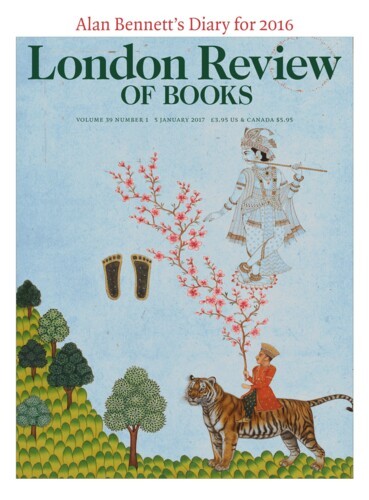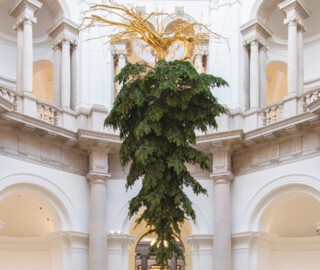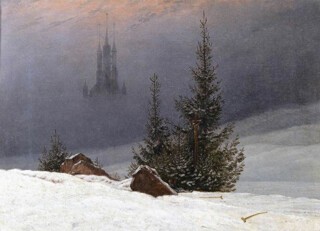At the carol concert in St Martin-in-the-Fields, two weeks before Christmas, shoppers and squawking babies filled the church’s elegant interior. It’s a sort of Christmas cake of a building, with dark panelling and white stucco icing, but the only hints of the season were the looping boughs of fir hung from the galleries. Outside, however, hundreds of men in Santa suits (who knows why?) were rushing around Trafalgar Square. The giant Norwegian fir that stands there every year – given annually since 1947 – must be the tallest Christmas tree in London, and the oldest: fifty years, compared to the ten weeks it takes to grow the living room sort. It’s not the prettiest, though, its only decoration is a cascade of lights that hang in vertical strips, almost erasing the tree itself. The one in the National Gallery next door, although not as big, is satisfyingly decked in ribbons and glass balls.
What you do to a tree makes a difference. I know whole families divided over the question of tinsel. Are flashing lights acceptable or only twinkling ones? Lights of many colours once seemed cheerful; now they look silly. Trees lit in purple and blue are the worst, and inevitably associated with corporate displays and aspirational attempts at chic (the ready-dressed blue and silver faux-fir). For the unsure, there are ‘treetorials’ at John Lewis or ‘Christmas design consultation’ for £250. They’ll even decorate your tree for you. Most companies are cleverer with their own displays now, and recognise the opportunity for spectacle. You don’t even need the tree – just a surprising triangle-shaped something. Last year Burberry created a Christmas tree out of gold umbrellas, this year English National Ballet have made one out of pointe shoes (there must be an appeal). Dwarf Christmas trees – as though they weren’t small already (in the forest they’d be 100 feet tall) – are thought fashionable by the Ritz and Kensington Council; elsewhere size is admired. Tate Britain have performed the feat of suspending theirs upside down. It looks quite uncomfortable with its roots all splayed out and spray-painted gold. I was pleased to hear that at King’s Cross a giant ice cube encasing a Christmas tree is gradually melting: how old-fashioned, the slow reveal! But in fact the ice is made of resin and wax, so the tree will never get to emerge at all.
Why a tree? Everyone says it’s because of Prince Albert, or at least Charlotte of Mecklenburg-Strelitz, wife of George III (so definitely a German tradition), but making a fuss of a conifer goes back further than that. A report from 1444 tells of a tree that was brought to Cornhill in the City of London and set ‘fast in the ground … for disport of Christmas to the people’. Not only this, but ‘every man’s house and also his parish church was decked with holme, ivie, bayes, and whatever the season of the year afforded to be green.’ Medieval poets and painters depicted the nativity scene full of flowers and April breezes; it was inconceivable that such a day could be bleak. It took a more sentimental age to romanticise the dark and cold (perhaps because they were further away from feeling it).
In a landscape turned bare and possibly white, the evergreen makes itself a declaration. Fir trees must have looked to Northern Europeans like the only life left on the earth, all other plants having sent their sap below. Caspar David Friedrich’s Winter Landscape (1811), a version of which is currently on display at the Towner Gallery (until 22 January), shows a snowy post-sunset scene with a group of pine trees in the foreground, and the dark form of a distant cathedral just visible in the pinkish evening mist. It seems as fanciful (and unfashionable) as a certain type of Christmas card, but churches sometimes do still half-emerge from the gloom like that, even in London – if there isn’t much street lighting. For Friedrich, the evergreen turrets found their equivalent in the cathedral’s slender spires. Gothic architecture in silhouette, with its crockets and finials, often echoes nature’s decorative outlines. Inside, embroidered stonework creates tangles of vegetation, hammerbeam timbers form a coppice canopy. Fan-vaulted ceilings make the allusion plain: their columns open out into great branches. The idea goes both ways. Robert Frost wrote of his forest of ‘young fir balsams like a place/Where houses all are churches and have spires’. As god is to man, Friedrich seems to say, so man is to nature: we are the ones who shape it, who isolate and set off its beauty. But the cathedral in the painting isn’t just a stone forest, it’s the world that is waiting for the almost hidden figure by the pines: a lame man who has thrown away his sticks. The spindly elevations of the scene promise some sort of ascension – perhaps he is being restored to uprightness.
Friedrich couldn’t have known the industry his trees would become (Frost had an inkling: ‘I hadn’t thought of them as Christmas Trees’). The sight of a fir farm, particularly in summer, is an unsettling one; it’s an immense global undertaking to grow and transport millions of trees every year. At the Christmas tree market they sell them by the foot – £10, which is more than silk. A Norway spruce is always nice (bushy, smells better, needles all fall out) but a Nordmann fir is the practical choice (darker, sparse, less character). The men doing the hauling wear Santa hats, but with what callous ease they throw the trees about, stripping their netting and fluffing up their greenery for passersby. The tree itself is not enough of course: it must be draped and decorated, and all over town the leafless ones that line the streets are covered with lights; wound around branches or suspended in clusters like balls of mistletoe.
The beauty of the bare and penumbral is harder to find; electric lights have chased away the ‘spectral grandeur of winter in London’, as Peter Davidson describes it in The Last of the Light, his book about dusk (Reaktion, £20). For a long time, the drawn-out twilights of the northern hemisphere were aestheticised; the year’s dwindling inspired nocturnes, night-pieces, winter songs, elegies. The moment of Friedrich’s painting had a philosophical significance for the Romantics – the moment after the sun has gone but something of its light still lingers, ‘as though brightness were falling from the air itself’. Dusk was an in-between time, when one might discern things that couldn’t be understood in daylight. It was also an artistic and scientific conundrum: how was it that light continued to be refracted after the sun had set, and why did foreground shapes remain clear while everything behind them dimmed? Ruskin studied this effect night after night, and in his essay ‘On the Beautiful’ described the different pleasures offered by dew on the grass, the glitter of the birch trunk, and the ‘deeper feeling of the beautiful’ inspired by the light of the declining day: ‘I am willing to let it rest on the determination of every reader … whether all that is dazzling in colour, perfect in form, gladdening in expression, be not of evanescent and shallow appealing, when compared with the still small voice of the level twilight behind purple hills.’
Davidson links this contemplative melancholy to the notion of belatedness; we are seeing our own mortality in the close of day and year. The hours of sunlight run by more quickly, and we’re left behind in the darkness. It’s hard now to feel the privation of former winters, or experience the desolation of the landscape; it’s not even likely to snow. But we see the trees unleafing, and sense the different strains of winter light: sometimes bright and cold, often thin and misted. Much of our enjoyment of this gauntness is in relief. Fasting for advent used to make a penitence of nature’s dearth, relieved at last by ecstatic abundance. On Christmas Eve congregations would hang the branches of the churchyard trees with apples. In Moscow, they deck avenues of leafless boughs with red and gold baubles, which has the same effect.
Our contrivance of these spots of colour has its roots in nature’s contingencies: red berries on a black branch, an evergreen tree in a field of snow – Ruskin’s lesser beauties perhaps. But it takes a mind to frame them, to put the tree in a painting or a living room. Sometimes novelty itself seems poetic, as though the product of design. During the Christmas floods a few years ago, an American acquaintance was overjoyed to be able to experience a ‘traditional’ British Christmas: candlelight, sputtering fire, no TV (the locals couldn’t quite see it that way). We aestheticise the tree by changing its setting, or we admire it through a picture. Christmas itself is a removal, separated from the rest of the year by its spangles and pageantry. The season makes us tourists of our own nostalgia; it’s best not to think too hard about the absurdity of chopping down a tree and covering it with tiny ornaments. What do we do with the wanwood when the new year comes? In the 16th century, after the feast and the dancing, the tree would be ceremonially burned, marking the end of festivities with a final brilliant spectacle, which does seem better than leaving it on the street for the council to collect.
Send Letters To:
The Editor
London Review of Books,
28 Little Russell Street
London, WC1A 2HN
letters@lrb.co.uk
Please include name, address, and a telephone number.



